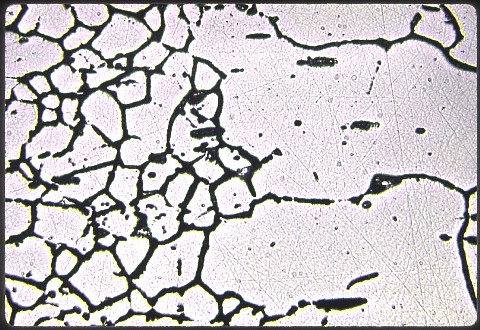Microstructures
by
George
Langford, Sc.D., Massachusetts Institute of Technology, Cambridge, MA,
1966
Copyright©2005 by George Langford
Cast Irons, High Alloy Steels,
and Superalloys - Lesson 2 -
Fifth specimen

|
This specimen is the same alloy as the previous one, but it
has been sensitized at 650C.
(a) Where is
this a problem ?
(b) How is it remedied ? and
(c) Why is the attack so nonuniform here ?
The photomicrograph was made at 200X, and the specimen was
deeply etched electrolytically in an oxalic acid solution.
|
Answers:
(a) Welds are particularly troublesome; (b) To cure the specimen of
sensitization, it must be homogenized at around 1100C and quenched; and
(c) Only the grain boundaries are attacked, because Cr4C cannot easily
nucleate elsewhere.
|
The nonuniform
grain size here is a bit of a mystery. A small deformation before
the previous annealing operation might have initiated discontinuous
grain growth; or exposure to a severe temperature gradient might have
coarsened the grains at the hotter end; or the piece may simply have
been grossly overheated. Note the absence of coring compared to
the previous specimen.
|
